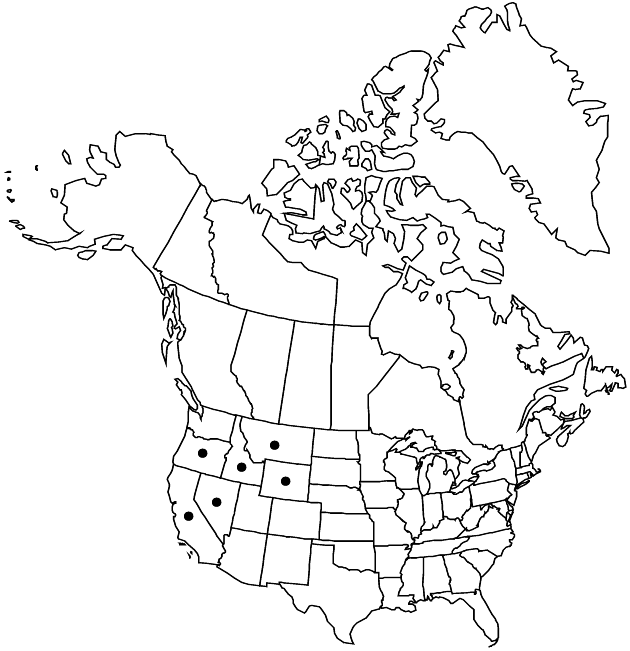Difference between revisions of "Cirsium cymosum"
Amer. Midl. Naturalist 30: 37. 1943.
FNA>Volume Importer |
imported>Volume Importer |
||
| Line 6: | Line 6: | ||
|place=30: 37. 1943 | |place=30: 37. 1943 | ||
|year=1943 | |year=1943 | ||
| + | }} | ||
| + | |special_status={{Treatment/ID/Special_status | ||
| + | |code=E | ||
| + | |label=Endemic | ||
}} | }} | ||
|basionyms={{Treatment/ID/Basionym | |basionyms={{Treatment/ID/Basionym | ||
| Line 33: | Line 37: | ||
-->{{Treatment/Body | -->{{Treatment/Body | ||
| − | |distribution= | + | |distribution=Calif.;Idaho;Mont.;Nev.;Oreg.;Wyo. |
|discussion=<p>Varieties 2 (2 in the flora).</p><!-- | |discussion=<p>Varieties 2 (2 in the flora).</p><!-- | ||
--><p>Past floras have treated <i>Cirsium cymosum</i> and C. canovirens as separate species. In my examination of these plants across their combined ranges I realized that they are connected by numerous intermediates and that I could find no characters that consistently distinguish them.</p> | --><p>Past floras have treated <i>Cirsium cymosum</i> and C. canovirens as separate species. In my examination of these plants across their combined ranges I realized that they are connected by numerous intermediates and that I could find no characters that consistently distinguish them.</p> | ||
| Line 64: | Line 68: | ||
|basionyms=Carduus cymosus | |basionyms=Carduus cymosus | ||
|family=Asteraceae | |family=Asteraceae | ||
| − | |distribution= | + | |distribution=Calif.;Idaho;Mont.;Nev.;Oreg.;Wyo. |
|reference=None | |reference=None | ||
|publication title=Amer. Midl. Naturalist | |publication title=Amer. Midl. Naturalist | ||
|publication year=1943 | |publication year=1943 | ||
| − | |special status= | + | |special status=Endemic |
| − | |source xml=https:// | + | |source xml=https://bibilujan@bitbucket.org/aafc-mbb/fna-data-curation.git/src/bb6b7e3a7de7d3b7888a1ad48c7fd8f5c722d8d6/coarse_grained_fna_xml/V19-20-21/V19_111.xml |
|tribe=Asteraceae tribe Cardueae | |tribe=Asteraceae tribe Cardueae | ||
|genus=Cirsium | |genus=Cirsium | ||
Revision as of 20:34, 27 May 2020
Biennials or perennials, 25–120 cm, pubescence a mixture of fine, non-septate arachnoid trichomes and coarser, septate trichomes, especially along stems and on midveins on abaxial leaf faces, usually ± loose and irregularly deciduous from leaves in age; taprooted. Stems usually 1, erect, ± gray-tomentose, sometimes villous with septate trichomes; branches 0–10+, usually arising in distal 1/2, ascending, usually reaching a ± common height. Leaves: blades linear-oblong to oblanceolate or elliptic, 10–30 × 3–7 cm, shallowly to deeply pinnatifid with 3–8 pairs of lobes, longer than 2 cm, lobes well separated, linear to triangular-ovate, dentate to lobed proximally, main spines slender, 2–7 mm, faces green to gray, thinly to densely arachnoid-tomentose with fine, non-septate trichomes, sometimes villous with septate trichomes along veins, usually ± loose and irregularly deciduous from leaves in age; basal often present at flowering, sessile or winged-petiolate; principal cauline mostly in proximal 1/2, winged-petiolate or sessile, bases narrowed, auriculate, veins often prominently raised on abaxial faces; distal sessile, auriculate-clasping or short-decurrent 1–10 mm, progressively reduced becoming bractlike, often unlobed or less deeply divided and sometimes spinier than proximal. Heads borne singly, terminal on main stem and branches, sometimes also in distal axils, erect, not subtended by well-developed leaves, collectively forming corymbiform or racemiform arrays. Peduncles (0–)2–15 cm. Involucres ovoid to hemispheric or campanulate, 2–3 × 1.5–3.5 cm, ± arachnoid-floccose, often glabrate. Phyllaries in 8–10 series, subequal to strongly imbricate, green, linear to lanceolate (outer) to linear (inner), entire, abaxial faces with inconspicuous to prominent glutinous ridge; outer and mid bodies loosely spreading to ascending or appressed, apices subappressed to ascending or spreading, flat, spines ascending to spreading, fine, 2–4 mm; apices of inner commonly flexuous or reflexed, narrow, flat, scarious. Corollas creamy white to purplish, 20–31 mm, tubes 8–14 mm, throats 5.5–10 mm, lobes 6–7 mm; style tips 4–6 mm. Cypselae tan to dark brown, 5–7.5 mm, apical collars not differentiated; pappi 16–25 mm.
Distribution

Calif., Idaho, Mont., Nev., Oreg., Wyo.
Discussion
Varieties 2 (2 in the flora).
Past floras have treated Cirsium cymosum and C. canovirens as separate species. In my examination of these plants across their combined ranges I realized that they are connected by numerous intermediates and that I could find no characters that consistently distinguish them.
Selected References
None.
Key
| 1 | Larger heads 20–35 mm diam.; outer phyllaries elongate, often nearly as long as inner; glutinous ridge narrow, weakly developed | Cirsium cymosum var. cymosum |
| 1 | Larger heads 15–25 mm diam.; outer phyllaries usually much shorter than inner phyllaries; glutinous ridge prominent, well developed, appearing dark brown on dry specimens | Cirsium cymosum var. canovirens |